The benefits and harms of wild rice for the human body
Wild rice is not the most famous and popular product in our market. He was undeservedly ignored, although among all species he is the most useful... Black rice contains many valuable micronutrients, it is low in calories, so it is added in the diet. The cereal is suitable for people of all ages, it is recommended when recovering from heavy operations.
The content of the article
Origin
The name "wild" or "black" rice has taken root in everyday life, but in fact it is mistaken. The fact is that this plant is not only cultivated for a long time, but also has nothing to do with rice. The long black grains are actually the seeds of the aquatic plant.
Tsitsania is an annual plant 1.5–3 m high from the Cereal family. It is found in swampy areas, on the shores of small rivers and lakes, like ordinary rice. Due to the similarity of cultivation, harvesting and methods of preparation of grain, tsitsania and began to be called rice.
In total, there are 4 subspecies of culture:
- Canadian;
- watery, or Indian;
- the black;
- wild.
Of these, 2 plant varieties are most common:
- The black (Zizania latifolia, or caduciflora). The homeland of the cereal is China. It is cultivated in the vicinity of Tibet, therefore it is sometimes called Tibetan. The stems, which are used in Chinese cooking, are of value. The shape of the grains resembles ordinary polished seeds of the "white brother", differing from them only in dark brown or black color. Earlier in China, this cereal was the food of the elite, the poor people could not even dream of black rice dishes. Now such grains are not at all expensive recyclable materials.
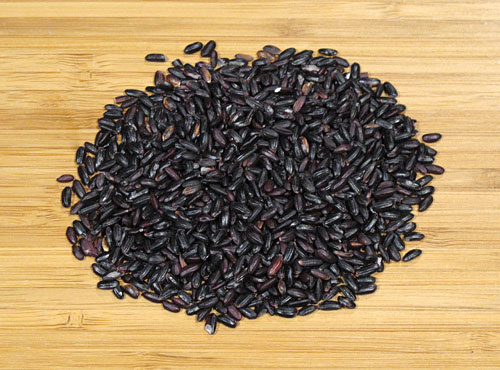
- Canadian (Zizania aquatica). Found in the area of the St. Lawrence River, on the border between Canada and the United States. It is because of the place of growth that the variety got its name. The grains of this plant are brown or black in color, strongly elongated and very dense. Slightly sweet on the palate; when cooked, they give a nutty smell and taste. Due to the high density of zitsania grains in cooking, they are soaked and then boiled for at least 40 minutes.
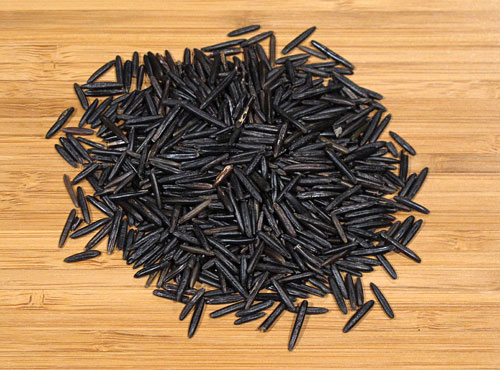
It is important! Sometimes unscrupulous producers, wanting to cash in, pass off cheap black rice as wild. Therefore, it is important to study the product before purchasing: the packaging should contain elongated, needle-like Zizania aquatica grains. Their differences are obvious if you compare the photo of Canadian rice and black.
Collection
For the first time, the plant was noticed by the Indians of North America and gave it the name Manomio, which translates as "good berry"... This cereal has been the basis of their diet for many centuries. The Indians swam in boats to the shoots of tsitsaniya and with sticks pounded the grain into sacks or directly to the bottom.
Harvesting wild rice is a laborious task that requires a certain skill. Grain grows exclusively in wetlands, making mechanical harvesting impossible. They get to the tsitsaniya on boats and collect grain by hand, as the Indians did hundreds of years ago. An experienced worker gets about 10 kg per hour.
The grain yield is much lower than that of ordinary rice, but in terms of quality this product belongs to the A + class. This explains the high cost of grains.
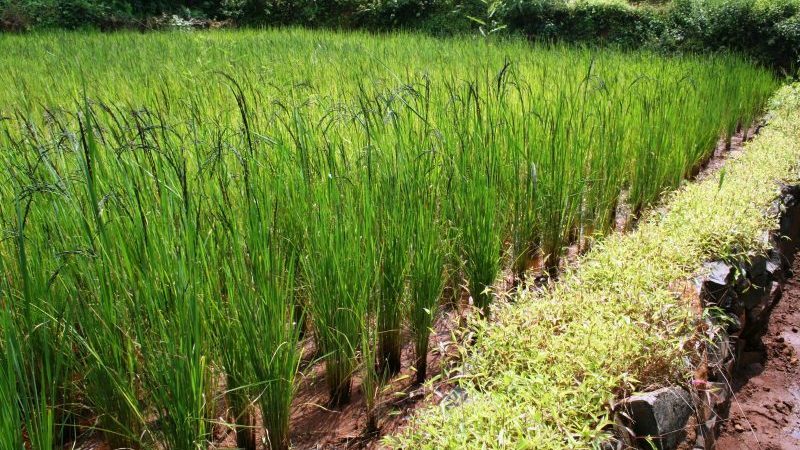
Composition
Nutritional value of boiled wild rice (per 100 g):
- calorie content - 101 kcal;
- fats - 0.4 g;
- carbohydrates - 61.7 g;
- proteins - 4 g.
100 g of the product contains:
- fiber - 2 g;
- vitamin B6 - 0.391 mg;
- folic acid - 0.095 mg;
- magnesium - 177 mg;
- phosphorus - 433 mg;
- zinc - 6 mg;
- copper - 0.524 mg;
- manganese - 1.3 mg;
- cholesterol - 0 mg.
Wild rice has a high content of vitamins, minerals, amino acids (more than 18 types, including threonine, lysine, methionine). It contains B vitamins (B1, B2, B5, B6, B9), PP, E and H, potassium, iodine, selenium, iron and sodium.
The antioxidant activity of the culture is almost 30 times higher than that of ordinary grains. The folic acid content is so high that only 150–170 g of the product provides a daily dose of the substance.
It is important! The main difference between wild rice and white and brown rice is the lack of processing (it is not cleaned or polished). This explains the unique composition of the cereal: all nutrients are concentrated in the shell of the grains, and processing makes them practically useless.
Benefit and harm
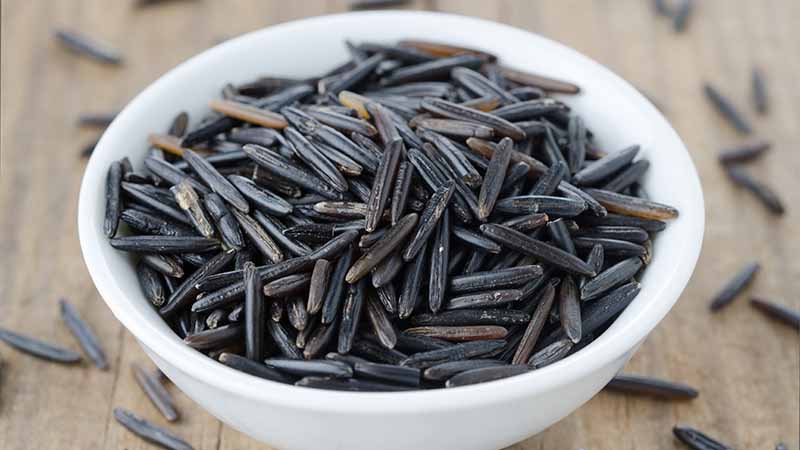
This is a useful product which has earned the unequivocal approval of nutritionists. The calorie content of wild rice is one of the lowest among cereals, which is important for those who follow a diet.
The grains are practically harmless. People are at risk with diseases of the gastrointestinal tract, in particular with a tendency to intestinal obstruction. Like regular rice, wild rice can lead to constipation.
Important! Nutritionists recommend combining grains with fresh vegetables and fruits.
The unique mineral and vitamin composition of the product has a positive effect on the body, supporting many processes and functions:
- strengthens muscles, gives vigor, strength, tones;
- prevents cardiovascular diseases, increases the elasticity of blood vessels;
- cleanses the blood of toxins and toxins, helps the body get rid of excess salt and cholesterol;
- stimulates the kidneys and bladder, thereby reducing the risk of edema;
- coarse fiber in grains stimulates the intestines, increases its blood supply, improves digestion;
- reduces blood pressure in hypertension;
- has a beneficial effect on vision;
- improves the general condition of hair, prevents hair loss and fragility;
- has a positive effect on the work of the brain;
- maintains a favorable condition of the patient with anemia;
- improves the functioning of the nervous system, prevents stress;
- accelerates metabolism, stimulates the regeneration of skin cells;
- slows down the aging process;
- increases the resistance of the immune system, relieves inflammation;
- favorably affects the work of the genitourinary system, therefore it is used in the treatment of diseases in this area;
- calcium in grains strengthens bones, reduces the risk of fractures and cracks;
- the rich amino acid composition makes up for the lack of animal protein in the diet of vegetarians.
For women
Wild rice is allowed to be consumed during pregnancy, since folic acid improves the well-being of the expectant mother and has a beneficial effect on the development of the fetus. Grain helps the body to recover from childbirth, anemia or blood loss.
The plant is also used to maintain beauty. To do this, the grains are ground into flour, from which face masks are prepared. The product improves the overall appearance of the skin, mattifies it, removes redness and inflammation, whitens it. Grain prevents hair loss, early gray hair, reduces nail brittleness.
Baby food
Black rice is recommended for children. It is hypoallergenic, therefore it perfectly fills the gaps in the diet of babies suffering from intolerance to certain foods.
The child is given cereal from the moment he learns to chew and swallow long grains.
It is important! Due to the lack of processing, the grain is much tougher than white rice, so it is important to ensure that the child does not choke.
A small amount of cereal for breakfast is good for filling. The fiber in grains is slowly digested, so you feel full persists for a long time.
Application in traditional medicine
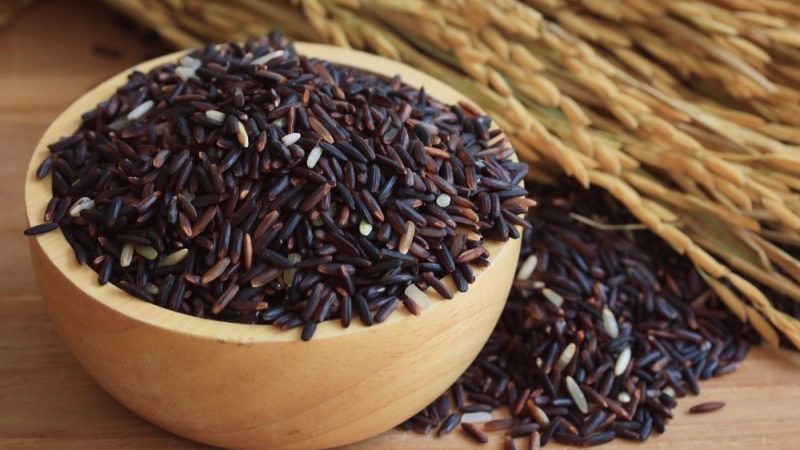
Wild rice is most widely used in Chinese traditional medicine. It is recommended for the elderly. Grain increases appetite and successfully cope with eating disorders, which often affect older people.
Black rice is good for diabetes prevention.
Grain sprouts are used in cosmetology. They are used to make face masks and infusions that improve the condition of the skin.
Contraindications
The product has no contraindications. Studies have not revealed any pronounced side effects from its use... However, the serving size should be controlled. The grains are very satisfying, so one handful is enough.
The plant lacks only two essential amino acids - asparagine and glutamine. Their deficiency is compensated by dishes made from beans, lentils or chickpeas.
The most tangible disadvantage of the product is its price. Tsitsania is grown in smaller quantities than white rice. The cost is influenced by high labor costs and low productivity of the plant. Therefore, black beans are much more expensive than white ones.
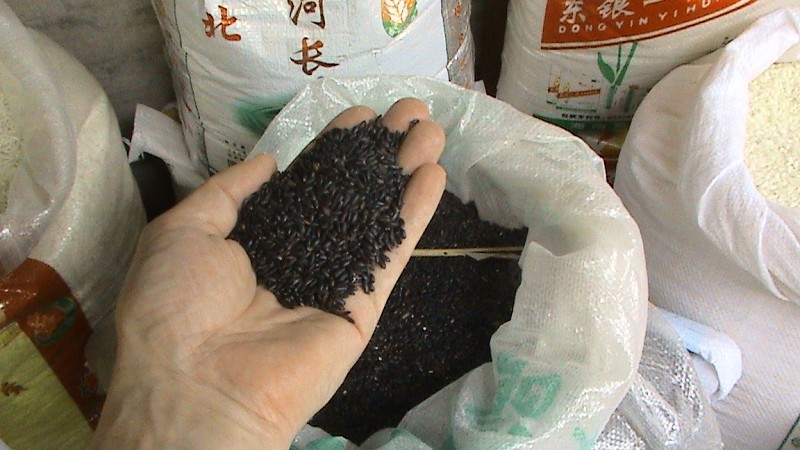
Conclusion
The benefits of wild rice for the body are undeniable. It is a valuable hypoallergenic product. It has a unique combination of nutrients and vitamins for cereals, so it is ideal for those who play sports, follow a diet or undergo rehabilitation after an illness.
The cereal is suitable for feeding both adults of all ages and children. Black grains are added to various dishes. It is only important to comply with the consumption rate and carefully study the product when buying.